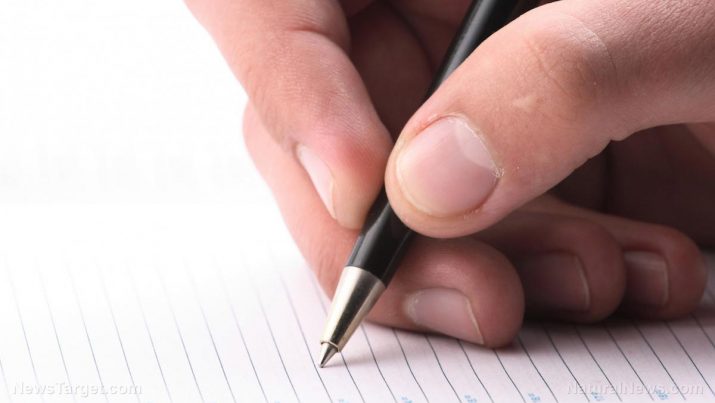
Writer’s cramp – causes, side effects and treatments at NaturalPedia.com
Thursday, August 02, 2018 by Zoey Sky
http://www.naturalpedia.com/writers-cramp-causes-side-effects-and-treatments-at-naturalpedia-com.html

Writer’s cramp refers to a specific type of focal dystonia that involves a patient’s hand, fingers, or forearm.
Focal dystonia of the hands is a neurologic movement disorder. This means the brain sends wrong information to the muscles, which then causes excessive and involuntary muscle contractions. The wrong signals can make a patient’s hands twist into strange positions.
Writer’s cramp is a task-specific dystonia, meaning it usually occurs when a patient performs a particular activity like playing a musical instrument or typing.
There are two basic types of writer’s cramp:
- Simple writer’s cramp – This involves difficulty with only writing. A patient may experience abnormal postures and involuntary movements when they pick up a pen. It only affects their writing ability.
- Dystonic writer’s cramp – This involves more than one task. A patient may experience symptom even if they are doing other tasks using their hands, like applying makeup or shaving.

Known symptoms of writer’s cramp
The symptoms of writer’s cramp usually include:
- Fingers extending during writing (this can make it hard to hold the pen)
- Fingers gripping a pen/pencil too hard
- Hands or fingers not responding to commands
- Wrists and elbows moving into strange positions
- Wrists flexing
Risk factors for writer’s cramp may include:
- Genetics
- Holding a pen/pencil improperly
- Overuse
- Poor writing posture
- Stress
Body systems harmed by writer’s cramp
Writer’s cramp may cause the following complications:
- Cramping in the muscles around the elbow and shoulder.
- The development of a second dystonia, e.g., the eyelids or vocal chords.
- Handwriting may gradually become illegible.
- Patients with simple writer’s cramp may develop dystonic writer’s cramp.
- Symptoms may also affect the other hand.
- Tremor or shaking that accompanies the cramping.
Food items or nutrients that may prevent writer’s cramp
The following foods or nutrients can help prevent writer’s cramp or address its symptoms:
- Magnesium – Magnesium is a mineral that promotes muscle relaxation and improves nervous system function. It can also address dystonia symptoms and support the healing process. Sources include Brazil nuts, dark chocolate, edamame, flaxseeds, molasses, oat bran, pumpkin seeds, sesame seeds, sunflower seeds, and wheat bran.
- Vitamin B-12/cobalamin – Vitamin B-12 can boost the immune system and it can help the body produce a myelin sheath, a white substance that coats the nerve endings and protects them from toxic damage. Vitamin B-12 also makes nerves healthier and it can reduce the effects of dystonia. Sources include eggs, ground beef, hard cheese, lamb, rabbit, sardines, and turkey.
- Vitamin D – Vitamin D is crucial for nerve communication. The vitamin can also soothe muscle spasms and reduce the severity of dystonia symptoms. Sources include catfish, cod liver oil, eggs, liver, milk, mollusks, shrimp, soy milk, and Swiss cheese.
- Vitamin E – An antioxidant, vitamin E can boost the immune system and protect the body from diseases, pollutants, toxins, and viral infections that can trigger dystonia. Vitamin E also repairs nerve and muscle damage and it can minimize dystonia symptoms like slurred speech and muscle spasms. Sources include almonds, broccoli, pine nuts, spinach, sunflower seeds, and tomatoes.
Treatments, management plans for writer’s cramp
There is no cure for writer’s cramp and treatment aims to address the symptoms of the condition. Treatment options for the disorder will vary depending on the type of writer’s cramp that a patient has.
Treatments for writer’s cramp may include:
- Botulinum toxin – This involves the injections of a medicine called botulinum toxin (botox) right into the affected muscles. The medicine must be re-injected at least every three months.
- Deep brain stimulation – This is a type of surgery.
- Medication – Medication can help relax the muscles in a larger part of the body and it can be given as tablets or via injections into a vein.
Patients with writer’s cramp can also benefit from occupational therapy and physiotherapy.
Where to learn more
Summary
Writer’s cramp is a task-specific dystonia, meaning it usually occurs when a patient performs a particular activity like playing a musical instrument or typing.
The symptoms of writer’s cramp usually include fingers extending during writing and hands or fingers not responding to commands.
Writer’s cramp may cause complications like cramping in the muscles around the elbow and shoulder and tremor or shaking that accompanies the cramping.
There is no cure for writer’s cramp. Treatment aims to address the symptoms of the condition. This may include botulinum toxin, deep brain stimulation, or medication.
Sources include:
Tagged Under: Tags: writer's cramp





